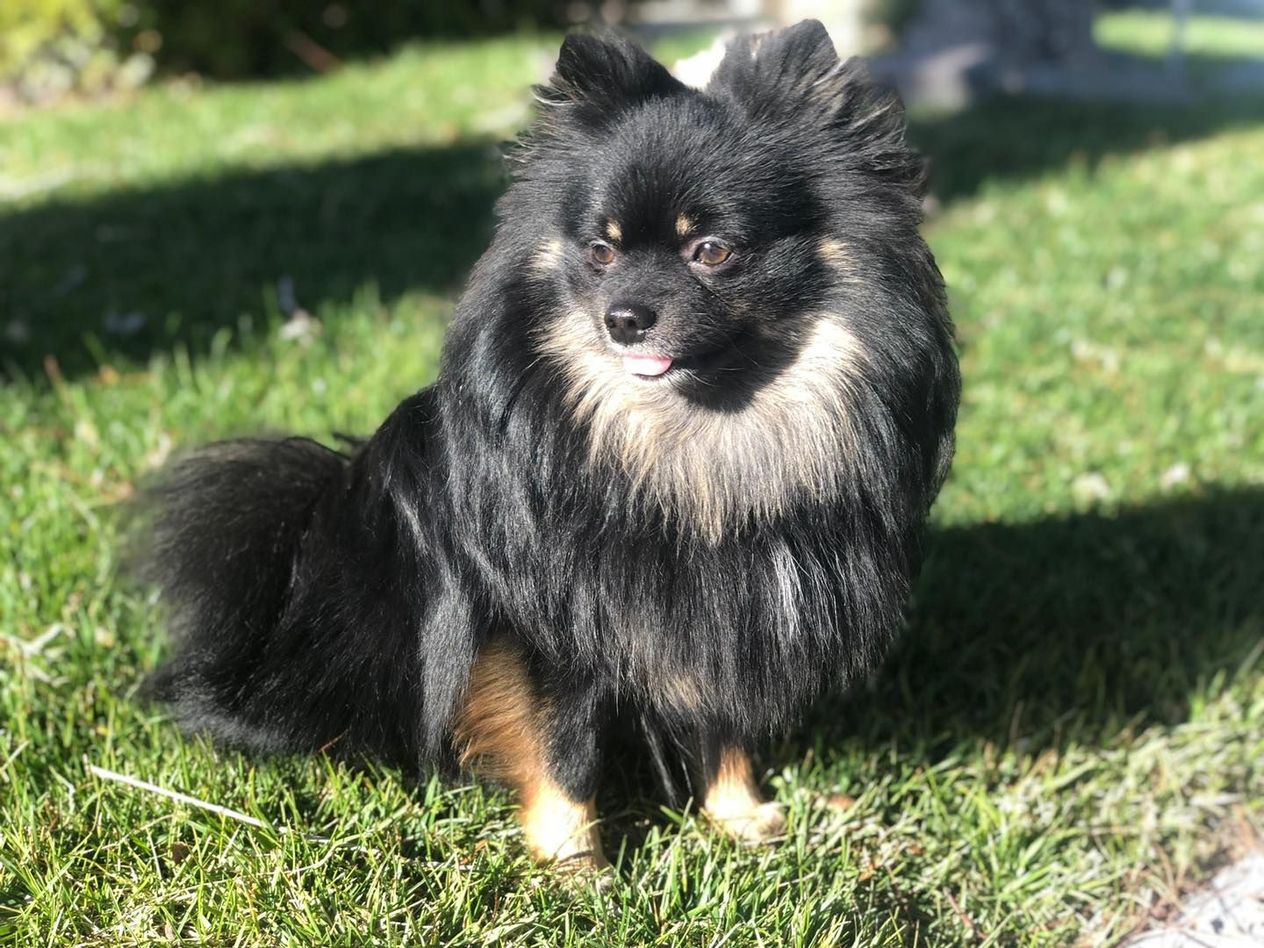Get to know
Pomeranians

Veterinarian reviewed
This miniature spitz puffball is really a fireball when it comes to personality.
Browse available puppies
Connect with reputable breeders to find the dog of your dreams
At a glance
Very Low Energy
Energy level
1/5
Low Maintenance
Grooming
3/5
Extra small
Size
Bold, energetic, playful
Temperament
12-16 years
Lifespan
More Challenging
Training
1/5
Vocal
Barking
4/5
At a glance
Energy level
Very Low Energy
Grooming
Low Maintenance
Size
Extra small
Temperament
Bold, energetic, playful
Lifespan
12-16 years
Training
More Challenging
Barking
Vocal
Why people love the breed
Poms just may be the cutest dog breed alive. They’re like a living puffball on tiny little piston legs, with a foxy smiling face.
Appearance
The Pom is a tiny spitz-type dog. Did we mention they are really cute?
Grooming
Although the coat is thick and dense, their small size makes grooming fairly easy.
BD Poms
Breed temperament and characteristics
Breed temperament and characteristics Poms are cute and they know it. Some of them seem to use that cuteness to get away with mischief.
Exercise
The Pom is energetic and playful. Fortunately their exercise needs can be met in limited space.
Pommies of LA
Training
True to their spitz heritage, Poms are not hop-to-it obedience dogs.
Diet and nutrition
Poms need high quality food to fuel their high activity level and grow their luxurious coat.
Truly Pomeranian
Health issues
Poms share several health problems with most other tiny dogs, but overall have fewer health concerns than most other popular breeds.
Lifespan: 12 to 16 years.
Patellar luxation
When the kneecap slips out of the groove in which it normally slides up and down, occurs in many toy breeds, including Pomeranians. In fact, the OFA reports that 31% of Poms in their database are affected.
Tracheal collapse
A health condition that occurs more often in small dogs, including Poms. It occurs in middle aged to older dogs, and can cause coughing and difficulty breathing.
Heart disease
The exact mode of transmission, or inheritance, is often unknown but it is recommended that breeding dogs are screened prior to breeding. The type and frequency of the screening examination performed varies by breed. Examples of heart disease in Poms include chronic heart valve disease, resulting in eventual heart failure.
Patent ductus arteriosus
This is a hereditary disease in which a fetal blood vessel remains open after birth (when it normally closes), causing a mix of oxygenated and deoxygenated blood.
Alopecia
Causes hair loss and black skin.
History
The Pomeranian is bred down from larger spitz breeds that pulled sleds, hunted large game, and guarded homesteads. They progressed to become one of the favored dogs of royalty and celebrities.
About the author
Canine specialist, Caroline Coile, Ph.D., is the author of 34 dog books, including the top-selling Barron's Encyclopedia of Dog Breeds. She’s written thousands of magazine and web articles about dogs. She specializes in canine science, health, breeds and competitions. Caroline has won 20 national dog-writing awards, and was a 2015 Inductee into the Dog Writers Association of America Hall of Fame.
Veterinarian reviewed
Dr. Nate Ritter, DVM is the Veterinary Medical Director at Good Dog. He earned his Bachelor of Science in Biology from Lafayette College and his Doctor of Veterinary Medicine degree from Virginia-Maryland College of Veterinary Medicine. He is a member of the American Veterinary Medical Association, New York State Veterinary Medical Society, the Veterinary Medical Association of New York City, and the Society for Theriogenology. Additionally, he is a USDA-accredited veterinarian.
Breed Scorecard
Characteristics and temperament
Affectionate with family
2
Watchdog level
4
Playfulness
4
Adaptability
3
Social needs
3
Temperament
Bold, energetic, playful
Intelligence
3
Good with other dogs
2
Good with cats or other pets
3
Friendly with strangers
1
Good as a service dog
1
Good for apartments
4
Barking level
4
Appearance
Height
6-7"
Size
Extra small
Colors
Chocolate parti, Orange parti, Black parti, Black and tan parti, Red parti, Cream parti, Lavender, Blue parti, Red, Orange, Cream, Black, Blue, White, Chocolate, Black and tan, Blue and tan, Blue merle, Chocolate and tan, Orange sable, Red sable, Wolf sable, Cream sable, Tri-colored, Blue sable, Chocolate merle, Beaver sable, Blue brindle, Brindle, Chocolate sable, Beaver, Black and brindle
Coat texture
Harsh outer coat, soft undercoat
Coat length
Medium
Training
Trainability
1
Exercise
Exercise needs
1
Exercise time
1/2 to 1 hour daily
Mental exercise needs
3
Favorite activities
Tricks
Grooming
Grooming needs
3
Brushing frequency
Daily
Needs professional grooming?
No
Drooling level
1
Health issues
Patellar luxation
Tracheal collapse
Heart disease
Patent ductus arteriosus
Alopecia
Other
Bred for
Companionship
Country of origin
Germany
Popularity level
5
FAQs
On Good Dog, you can search for Pomeranian puppies or dogs in rescues and shelters. Adopting a Pomeranian from a shelter or rescue is generally less expensive than buying a puppy from a breeder with ethical practices. Across the United States, there are dedicated rescues that specialize in specific breeds and may even help transport a Pomeranian dog to you from another part of the country. Although it can be more cost-effective, adopting the exact breed you're looking for is typically more difficult than working with a responsible breeder. Learn more about adopting a dog from a shelter or rescue.
Prices for Pomeranian puppies for sale vary by breeder and individual puppy. On Good Dog today, Pomeranian puppies are typically around $2,600. Because all breeding programs are different, you may find dogs for sale outside that price range.
They are cuddly, but because of their thick coat, they can overheat and leave if you try cuddling on a warm day. They're generally happier sitting beside you.
They shed twice a year, but their smaller size means that even a major shed won't have your house covered in fur-–maybe your lap, though.
Poms are fun and active housepets, very gentle with everyone. They may not be super obedient, but their cuteness makes up for it. They can bark a lot, so take that into consideration.



